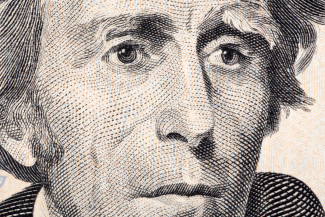
Johns Hopkins UniversityEst. 1876
America’s First Research University
The Coming of Democracy: Presidential Campaigning in the Age of Jackson

I originally intended to write a book on the 1840 presidential campaign, often hailed as the first modern election. As I researched, however, it became clear that 1840 marked the culmination, not the beginning, of a set of election practices that we can recognize in modern-day campaigns. The Coming of Democracy: Presidential Campaigning in the Age of Jackson examines the emergence of this use of cultural politics during the period between the 1824 and 1840 presidential elections.
I discuss several examples of Jacksonian-era cultural politics in the book, but two of the most fascinating to me are material culture and visual culture. By material culture, I mean tangible objects created or displayed to show support for a candidate. In the 1828 campaign, this meant buttons, flasks, and snuff boxes celebrating Andrew Jackson as the Hero of New Orleans. During Jackson’s second term, the Whigs produced buttons and coins to emphasize what they perceived as his despotic tendencies.
But these presidential campaigns also used other objects that symbolized support for their candidate. Throughout the period, Democrats utilized hickory twigs, branches, and trees to demonstrate their commitment to Jackson, whose nickname “Old Hickory” spoke to his toughness and durability during the War of 1812. Indeed, Jackson’s strength in the face of formidable challenges was one of his main attractions to his supporters. In 1840, Whigs employed log cabins and hard cider in their effort to portray their candidate, William Henry Harrison, as a man of humble origins who regularly partook in a common American drink.

Visual culture also grew in importance during this period. The development of lithography, which allowed for the quick, cheap printing of detailed images, encouraged the ubiquitous creation of political cartoons. Jackson’s opponents were quick to employ this new technology, generating dozens of anti-Jackson, anti-Democratic cartoons between 1824 and 1840. These images often portrayed a Jackson administration in chaos. Jackson’s successor, Martin Van Buren, fared little better. His presidential administration was hampered by a severe economic depression, which allowed Whigs to portray him as an out-of-touch elitist intent on continuing Jackson’s monarchical tendencies.
The significance of these two types of cultural politics can be seen today. Take the “log cabin and hard cider” symbolism of the Whig’s 1840 campaign. Never mind that Harrison came from a wealthy background—the rhetoric worked, setting the stage for future candidates to position themselves as average Americans. Witness billionaire Donald Trump’s ubiquitous wearing of red ball caps during the 2016 campaign to mark his connection to working-class Americans, a comparison he reinforced early in his presidential administration by referencing his and Andrew Jackson’s fight against “an arrogant elite.” Trump’s main opponent in 2016, Hillary Clinton, was worth an estimated $45 million, yet she positioned herself as the “champion” of “everyday Americans.”
Political cartoons remain a part of modern political culture, but in the today’s world of social media, memes have overtaken them in importance. Memes, typically viral images or videos accompanied by humorous captions, provide shorthand political commentary. For example, a Harry Potter-inspired meme depicted Clinton as Dolores Umbridge, an ambitious, unlikeable witch, and Trump as Lord Voldemort, the bullying “Dark Lord” nemesis of everyone’s favorite young wizard. Other memes encapsulated campaign themes as well. Trump endorsed one depicting him as Pepe the Frog, leading Democrats to accuse him of pandering to the white supremacists who embraced the image and whom they considered a critical part of his base. Clinton’s reference to part of Trump’s supporters belonging in “the basket of deplorables” allowed Republicans to create memes accusing her of “viciously demonizing hard working” Americans.
Of course, politicians and voters of the Jacksonian period could hardly have imagined how Americans would be using and adapting their forms of cultural politics nearly two hundred years later. Yet, it is important to recognize that presidential candidates, even those in the twenty-first century, owe a debt to the five presidential campaigns that occurred between 1824 and 1840.
Mark R. Cheathem is a professor of history at Cumberland University, where he also directs the Papers of Martin Van Buren. He is the author of The Coming of Democracy: Presidential Campaigning in the Age of Jackson and several other books on the Jacksonian era, including Andrew Jackson and the Rise of the Democratic Party and Andrew Jackson, Southerner.


